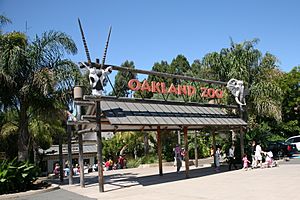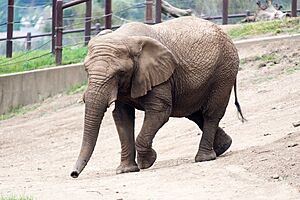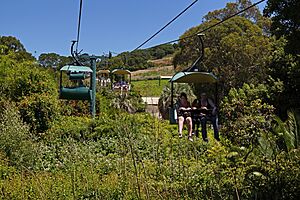Oakland Zoo facts for kids

Main entrance
|
|
| Date opened | 1922 |
|---|---|
| Location |
|
| Land area | 100 acres (40 ha) |
| Coordinates | 37°45′03″N 122°08′52″W / 37.7508°N 122.1477°W |
| No. of animals | 850+ |
| Annual visitors | 975,000 |
| Memberships | AZA |
The Oakland Zoo is a fun place to visit in Oakland, California, USA. It first opened on June 6, 1922. A group called the Conservation Society of California runs the zoo. They are a non-profit organization that works to protect animals and nature all over the world. The zoo is home to over 850 different animals, from local wildlife to animals from far-off lands. It's also part of the Association of Zoos and Aquariums (AZA), which means it meets high standards for animal care.
Contents
The Zoo's Journey: A Look at Its History
The Oakland Zoo was started by a naturalist named Henry A. Snow. It first opened on June 6, 1922, in downtown Oakland. The area where it first stood is now a park called Snow Park.
Over the years, the zoo moved a few times. It went from Sequoia Park to Joaquin Miller Park. Finally, in 1939, it moved to Durant Park. This land was bought by California in 1950. It was then renamed Joseph Knowland State Arboretum and Park.
In 1936, Henry A. Snow's son, Sidney Snow, created a non-profit group. It was first called the Alameda County Botanical and Zoological Society. This group later became the East Bay Zoological Society. From 1982 until 2017, this society managed the zoo for the City of Oakland. In August 2017, its name changed to the Conservation Society of California. This new name shows the zoo's strong focus on protecting wildlife.
The zoo works with over 25 wildlife conservation groups around the world. It helps fund their projects to save animals. They also work with the California Department of Fish and Wildlife. Together, they help rescue and care for animals affected by wildfires or human conflicts. This has included many animals like mountain lions, California condors, bears, and yellow-legged frogs.
Growing Bigger: New Exhibits and Programs
The Oakland Zoo has added many new and improved homes for its animals. These include new exhibits for hamadryas baboons and chimpanzees. A large home for elephants was built in 1987. The sun bear exhibit opened in 1995. It was even shown on the TV show Ultimate Zoos. White-handed gibbons live on a green island in the Tropical Rainforest area. The African Savannah, with animals like camels, lions, and giraffes, was finished in 1998.
The zoo's Education Center opened in 1999. A new main entrance followed in 2001. Later that year, a squirrel monkey exhibit opened. The tiger exhibit was also made larger and better. In 2007, the dromedary camels moved to a bigger, fenced area.
The Oakland Zoo offers free or low-cost science programs. These programs are for students from schools that need extra support. The zoo gives out 5,500 vouchers each year. This is part of its Zoo-to-Community program. It helps over 3,000 students and 1,000 adults learn about animals every year.
In 2012, a new veterinary hospital opened. It was built to be very energy efficient. In 2013, the Oakland Zoo Biodiversity Center opened. Then, in 2014, the Condor Recovery Center started. All these projects help the zoo care for its animals. They also help protect animal species in the wild.
Exploring the California Trail
The California Trail section opened in the summer of 2018. It is located at the top of a hill above the main zoo. This project cost $70 million. The trail shows how humans and nature are connected in California. It also highlights how changes affect them.
Visitors ride an aerial gondola from the main zoo to reach the trail. Along the trail, they can see animals like bears, wolves, and mountain lions. There is also a playground called California Wilds! for younger children. It has play structures based on California wildlife. Inside the Conservation Habitarium, visitors can learn about California's different habitats. They can also see grizzly bears through a large window. This area helps people understand how they can help protect California's wildlife.
California Trail is an example of the Oakland Zoo's leadership in captive animal welfare, and its commitment to providing natural and enriched environments to promote species-typical behaviors for captive wildlife. California Trail is a model for other zoological facilities, sending the critical message that zoos have an important role to play in the rescue, rehabilitation, and care of wildlife...Oakland Zoo has long prioritized common sense and welfare, and PETA looks forward to continued collaboration on improving the welfare of captive wildlife across the U.S.
Fun at the Children's Zoo
In the summer of 2005, the Wayne and Gladys Valley Children's Zoo opened. It is about 3 acres in size. It has new animal exhibits and fun play areas for kids. Here you can find lemurs, tortoises, and a special area where you can pet goats and sheep. There are also river otters, alligators, bats, pigs, and rabbits. The Children's Zoo also has a Bug Room and a Reptile and Amphibian Discovery Room.
One cool feature for younger kids is the brass insects. They are set into the concrete walkways. The Clorox Wildlife Theater is also in the Children's Zoo. It hosts many animal shows with all kinds of creatures.
Amazing Animals at Oakland Zoo
Flamingo Plaza
Tropical Rainforest
African Savanna
- African elephant (formerly)
- African lion
- African sacred ibis
- Ball python
- Black-throated monitor
- Blue-bellied roller
- Common warthog
- Dromedary camel
- Egyptian goose
- Fischer's lovebird
- Giant plated lizard
- Grant's zebra
- Hamadryas baboon
- Hamerkop
- Hooded Vulture
- Klipspringer
- Meerkat
- Pancake tortoise
- Pied crow
- Red-bellied parrot
- Red-tailed monkey
- Reticulated giraffe
- Rock hyrax
- Speckled pigeon
- Spotted hyena
- Sudan plated lizard
- Superb starling
- Taveta weaver
- White-faced whistling duck
Wayne and Gladys Valley Children's Zoo
- African spurred tortoise
- Aldabra giant tortoise
- Amazon tree boa
- American alligator
- Asian forest scorpion
- Black beauty stick insect
- Black tree monitor
- Black widow spider
- Blue spiny lizard
- Brown anole
- Caribbean giant cockroach
- Chilean rose tarantula
- Chuckwalla
- Colombian red-tailed boa
- Common carrion beetle
- Crowned lemur
- Desert tortoise
- Domestic rabbit
- Dyeing poison dart frog
- Eastern box turtle
- Florida red-bellied cooter
- Giant African millipede
- Giant vinegaroon
- Gila monster
- Goat
- Golden mantella
- Golfodulcean poison frog
- Green and black poison dart frog
- Green anole
- Green mantella
- Guinea Hog
- Henkel's leaf-tailed gecko
- Island flying fox
- Jungle nymph
- Large flying fox
- Leafcutter ant
- Madagascar hissing cockroach
- Mission golden-eyed tree frog
- North American river otter
- Panamanian golden frog
- Ring-tailed lemur
- Spotted turtle
- Three-toed box turtle
- Yellow-banded poison dart frog
Wild Australia
California Trail
Glowfari: A Dazzling Light Show
Glowfari is a special light event the zoo hosts in the winter. It features huge, glowing lantern animals. The path is one mile long and has over 100 animal lanterns. There are also more than 800 other light displays. You can explore three different worlds: Aquatic, Ecosystem/Food Chain, and Jurassic (dinosaurs).
Osh the Elephant: A New Home
On July 9, 2024, the Oakland Zoo announced that Osh, their last elephant, would be moving. Osh, a 30-year-old male, moved to The Elephant Sanctuary in Tennessee later that fall. This is the same place where the zoo's previous elephant, Donna, now lives. This decision was made because elephants are very social animals. It was recommended that Osh move to a place where he could be with other elephants. The zoo has not yet announced what they will do with the former elephant area. Osh left Oakland on October 16, 2024, and arrived at his new home two days later after a long road trip.
Images for kids














